#a peculiar parish edition
Text
IMMACULATE - Review
DISTRIBUTOR: NEON

SYNOPSIS: Sister Cecilia experienced a life-altering event that led her to seek solace in religion—a near-drowning incident in an icy lake. Time passed, and the closure of her initial parish prompted Father Sal Tedeschi to extend an invitation for her to join a secluded convent nestled within the picturesque Italian countryside. This convent serves as a sanctuary for nuns nearing the end of their lives. However, as Cecilia spent more time in this idyllic setting, certain peculiarities in the convent's lifestyle began to unsettle her. A fellow nun named Gwen is a constant shadow, stalking her every move. To Cecilia's shock, a medical examination revealed the unthinkable—she was pregnant despite being a virgin and having never engaged in any physical relations with a man. The warm welcome she had initially received turned into a chilling nightmare as the horrifying truth emerged: the convent concealed a sinister secret, a place where unspeakable horrors took place.
REVIEW: The talented trio of director Michael Mohan, writer Andrew Lobel, and actress Sydney Sweeney collaborate on a captivating narrative that explores a “what if” scenario where Ira Levin and William Peter Blatty join forces to create a contemporary allegory, set against the backdrop of the Catholic church and helmed by the visionary Dario Argento. This film delves into themes that resonate with the zeitgeist, promising a thought-provoking and immersive cinematic experience.
Andrew Lobel has crafted a remarkable screenplay that initially presents itself as a conventional horror film, providing an entertaining experience on its own. However, upon closer examination and in the context of current events, the narrative transforms into an allegorical tale. A pivotal plot point is that Sister Cecilia is an American nun whose journey holds deeper significance. Considering that nuns adopt the names of saints, the reference to Saint Cecilia, a martyr sentenced to death for refusing to worship Roman gods, becomes intriguing when viewed in light of the film's brutal and horrifying climax. The film explores various themes, including women's rights, In vitro fertilization (IVF), abortion, evangelical beliefs about end times, and the patriarchy.
Cecilia's character arc is masterfully written, portraying her as a resilient fighter and survivor. As her faith is put to the test, she emerges as a force of nature, visually depicted through her own rebirth. The film presents a compelling saga that leaves an enduring impression.
The production design and cinematography in IMMACULATE recreate the visual and atmospheric style of great genre films from the late 60s and early 70s. The film evokes memories of classics like "Rosemary's Baby," "The Omen," "Don't Look Now," and "The Exorcist." The costumes are excellent, the locations are fantastic, and the special effects are just gory enough to create a truly unsettling atmosphere. The editing, framing, and lighting combine to create some genuinely scary moments. While the film's darkness can sometimes be excessive, it effectively builds tension without compromising the atmosphere. Composer Will Bates contributes a brilliant score that perfectly complements the visuals and enhances the viewing experience. There are particularly impressive moments where the orchestrations recall the iconic genre scores composed by Goblin. Bates's score for IMMACULATE will be a standout addition to my collection.
Actress Sydney Sweeney leads a magnificent ensemble cast. She creates this innocent Carrie White character that goes on an intense quest of faith and morality that evolves from victim to victor. In the film's climax, the audience is taken on a journey through a primal, gut-wrenching moment, which is enhanced by the powerful performance of the lead actress. The rest of the cast contributes to the creation of a mysterious and unsettling atmosphere, adding another layer to the sense of dread that permeates the convent. Their performances provide a compelling argument against blind faith and highlight the dire repercussions of one's actions. The performances elevate the material, giving it a greater impact and leaving a lasting impression on the audience.
Seldom does a horror film emerge that boldly challenges conventions and elevates the genre's standards. A distinguished genre film, much like great genre literature, seamlessly blends a captivating narrative with insightful social commentary. IMMACULATE masterfully combines an intricate storyline, artistic and stylized filmmaking, and a talented cast to create an unforgettable cinematic experience. Transcending the boundaries of the horror genre, IMMACULATE establishes itself as a timeless and significant cinematic masterpiece that will leave you questioning the supposed altruistic actions of organized religion and politics.
CAST: Sydney Sweeney, Álvaro Morte, Simona Tabasco, Benedetta Porcaroli, Giorgio Colangeli, Dora Romano, Giulia Heathfield Di Renzi, Giampiero Judica & Betti Pedrazzi.
CREW: Director - Michael Mohan; Screenplay - Andrew Lobel; Producers - David Bernad, Sydney Sweeney, Jonathan Davino, Teddy Schwarzman, & Michael Heimler; Cinematographer - Elisha Christian; Score - Will Bates; Editor - Christian Masini; Production Designer - Adam Reamer; Costume Designer - Francesca Maria Brunori; Special Effects Supervisor - Paolo Galiano; Visual Effects Supervisor - Victor Perez.
OFFICIAL: neonrated.com
FACEBOOK: www.facebook.com/neonrated
TWITTER: twitter.com/neonrated
TRAILER: https://youtu.be/RLxneCiRInw?si=UMDWy43JYJVghw1g
RELEASE DATE: In theaters March 22nd, 2024
**Until we can all head back into the theaters our “COVID Reel Value” will be similar to how you rate a film on digital platforms - 👍 (Like), 👌 (It’s just okay), or 👎 (Dislike)
Reviewed by Joseph B Mauceri
#film review#movie review#immaculate#neon#michael mohan#andrew lobel#sydney sweeney#horror#religious#thriller#joseph b mauceri#joseph mauceri
2 notes
·
View notes
Photo

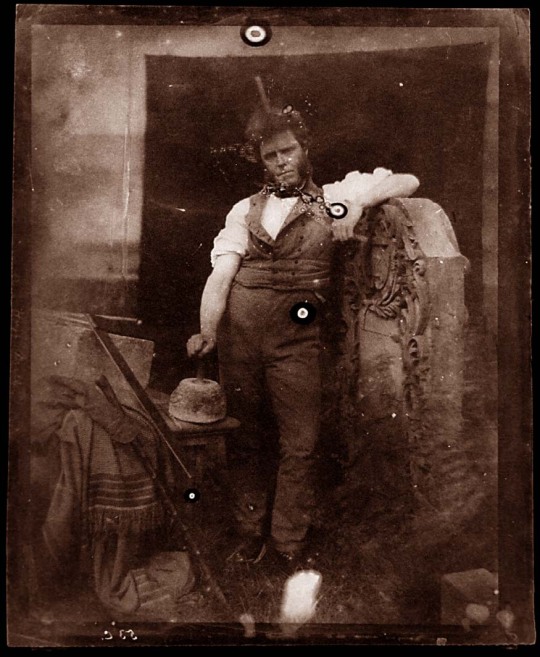
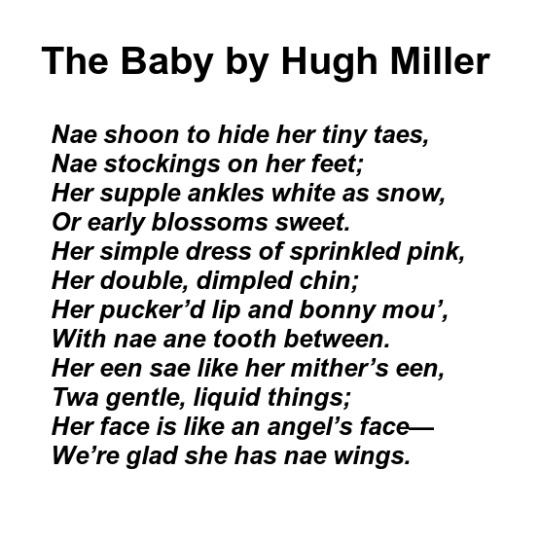


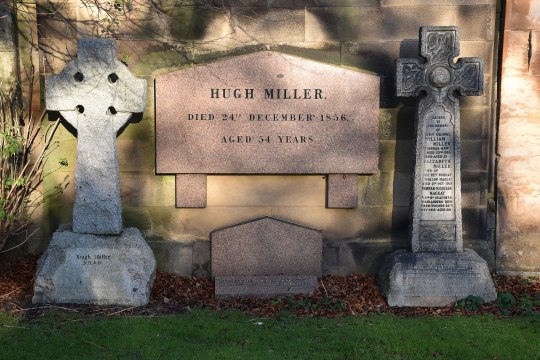
On October 10th 1802 writer and geologist Hugh Miller was born at Cromarty.
10th October is World Mental Health Day 2022, I dedicate this post to this occasion. A suitable quote by the man is “Problems are only opportunities with thorns on them.”
Hugh Miller was the first of three children of Harriet Wright and Hugh Miller, both parents were from trading and artisan families in Cromarty. His father died in a shipwreck in 1807, and he was brought up by his mother and uncles. He was educated in a parish school where he reportedly showed a love of reading.
At 17 he was apprenticed to a stonemason, and his work in quarries, together with walks along the local shoreline, led him to the study of geology. But Hugh developed a keen interest in many subjects. In later life he was a true polymath, having a keen interest in writing, religion and social issues.
From an early age his was an enquiring and lively mind. Of course he famously observed that ‘Life is itself a school and nature always a fresh study’. A self-taught geologist he made an early breakthrough in discovering his famous ‘winged-fish’, the fossil remains of an early, 390 million year old, ‘Old Red Sandstone’ armoured fish that had peculiar wing-like fins.
Even in the throngs of Edinburgh, where he moved to edit the Presbyterian newspaper – The Witness – he cut a dash. His appearance helped him stand out from the crowd; he grew to be 6’2” and had a full and flowing head of red hair. As his journalism progressed so did his immense fossil collection and by the time of his death at the age of 54 he had amassed a collection that ran to over 6,000 specimens and later became the founding core of what is today’s Scottish national collection in the National Museum of Scotland in Edinburgh. Such is the value of this collection that it continues to be studied by palaeontological researchers to this day.
Miller was just as prolific with his pen and published vast numbers of articles, scientific papers and books, as well as giving many lectures. His most successful work is reckoned to be his The Old Red Sandstone, or New Walks in an Old Field which came out in 1841.
Hugh Miller was plagued with silicosis, but also with frequent headaches and mental illness. On December 23rd through to the early hours of the 24th 1856, he suffered such an attack of depression that he took his own life , he left a note saying;
Dearest Lydia, -- My brain burns ... and a fearful dream rises upon me. I cannot bear the horrible thought. God ... have mercy upon me. Dearest Lydia, dear children, farewell. My brain burns as the recollection burns. My dear, dear wife, farewell.
12 notes
·
View notes
Text
“Common sense is the enemy of romance,”
— wrote Oscar Wilde, in response to an invitation to join the Thirteen Club, a London society that sought to debunk superstition,
“Leave us some unreality.”

The entire quote above is part of the leading paragraph in my newly purchased zine “A Purple Thread: The Supernatural Doom of Oscar Wilde”.
OH, how I love delving into this stort of mystery 🖤💜🖤 Happy Friday, dear friends 💜 I hope you get to enjoy some (romantic) unreality this weekend 😘
#oscar wilde#oscar wilderness#fiddlers green#a peculiar parish edition#A Purple Thread#its friday bitches#quote#litterature#dark academia aesthetic#dark academia
20 notes
·
View notes
Text
My Witch Library (Oct 2019)
Planners/Calendars
Llewellyn’s Witches’ Date Book 2019
Llewellyn’s Witches’ Calendar 2019
Introductory Books (General Witchcraft):
Enchantments: A Modern Witch’s Guide to Self-Possession; Mya Spalter (First Edition, First Printing)
Introductory/Reference Books (Wicca, Scott Cunningham)
Wicca: A Guide for the Solitary Practicioner (First Edition, 12th Printing)
Living Wicca: A Further Guide for the Solitary Practicioner (First Edition, Second Printing)
The Complete Book of Incense, Oils & Brews (First Edition, 38th Printing)
Cunningham’s Encyclopedia of Crystal, Gem & Metal Magic (Second Edition, 17th Printing)
Cunningham’s Encyclopedia of Magical Herbs (Expanded & Revised Edition; Second Edition, 29th Printing)
Cunningham’s Encyclopedia of Wicca in the Kitchen (Third Edition, 12th Printing)
The Magical Household: Spells & Rituals for the Home; Cunningham & David Harrington (First Edition, 24th Printing)
Introductory Books (Wicca, other authors)
Wicca for Beginners: Fundamentals of Philosophy & Practice; Thea Sabin (First Edition, 14th Printing)
Exploring Wicca: The Beliefs, Rites, and Rituals of the Wiccan Religion; Lady Sabrina
Moon Magic
Moon Magick: Myths & Magick, Crafts & Recipes, Rituals & Spells; D.J. Conway (First Edition, 15th Printing)
Tarot Decks
The One World Tarot; Crystal Love & Michael Hobbs (Second Printing)
Books on Tarot
Guide to the Pythagorean Tarot: An Interpretation based on Pythagorean and Alchemical Principles; John Opsopaus, illustrations by RHO (First Edition, First Printing)
Fairy/Faerie Magic
The Vanishing People: Fairy Lore and Legends; Katharine Briggs, illustrations by Mary I. French (First American Edition)
Folk Stories/Fairy Tales
Irish Folk & Fairy Tales: Omnibus Edition; Michael Scott (First Edition, First Printing)
Zines
Fiddler’s Green: Peculiar Parish Magazine (Clint Marsh, editor/publisher)
Volume 1 - Number 4
Volume 2 - Number 1 (May 2018)
Volume 2 - Number 2 (February 2019)
Fiddler’s Green Leaflets (Clint Marsh, author)
Nine Defenses Against The Basilisk: Black & White Magic for Surviving Anxiety; illustrations by Alexis Berger (FG1102)
The Place of the Song-Dream: The Animal Spirituality of Kenneth Grahame; illustrations by Timothy Renner (FG1103)
Armchair Demonology: The Magical Benefits of Cultivating Bad Habits; illustrations by Gerhard (FG1104)
Exploding the Tangerine: A Shy Person’s Guide to Battle Magic; illustrations by Oliver Bly (FG1201)
Enchantment Dismantled: Superstition and the Thinking Irrationalist; illustrations by Kelly Patton (FG1202)
Our Bogeys, Our Shelves: The Magician’s Library as Mentor, Companion & Oracle; illustrations by Jeff Hoke (FG1301)
The Riddle of the Sphinx: The Artist’s Path and the Secrets of Immortality; illustrations by Adrienne Rozzi (FG1302)
Non-occult Zines
Herbal First Aid: Assembling a Natural First Aid Kit; Raleigh Briggs (Microcosm Publishing)
#magick#library#mine#october 2019#books#zines#tarot decks#moon magic#introductory books#reference books#planners#calendars#encyclopedias#leaflets#fairy tales#fairy magic#scott cunningham#clint marsh#peculiar parish#fiddler’s green#Llewellyn publishing#wicca#witch library#herbal first aid
8 notes
·
View notes
Text
The Devils of Spring
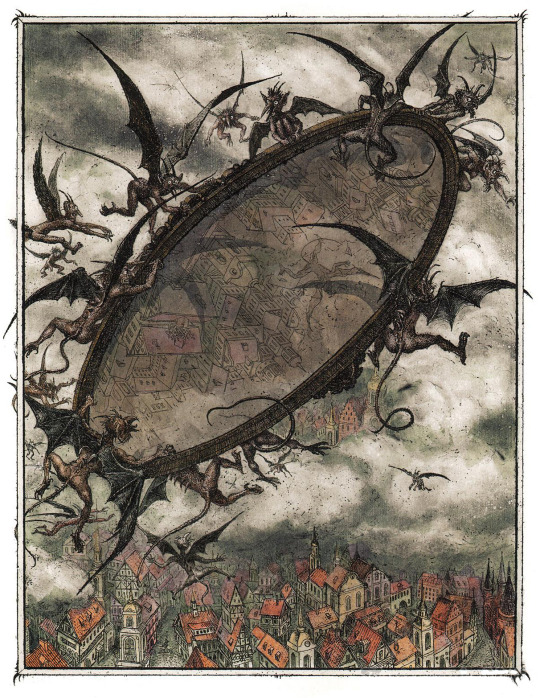
After a considerable effort all 485 preorders of the Skeptical Occultist Journal issue four are now in the post. Keep an eye out for them and do post pictures on social media when they arrive. Especially those who have gotten the early preorder special marbled dust wrappers. Orders have come from over 20 countries around the world, thanks to everyone who ordered! We have just 15 copies left before it is already out of print!
There is a great deal of work I will be attending to over the summer and I fear Skeptical Occultist shall suffer for it in terms of posts. I have several articles for various publications to finish, as well as having started the editing of two new volumes out late this year on Alkahest Press. I will try to get out some reviews and a few short pieces I have been thinking of on a handful of topics as the months progess.
After the great Fiddler's Green reviewed my book Wyrdwood it has now sold out from Alkahest Press. We are considering a second run of the book but unlikely before the end of summer. From the review:
"The author doesn't present academic folklore, nor actual spells. These essays instead explore aspects of everyday witchery as observed by a longtime practitioner in a self-possessed, unobtrusive prose style that feels like a quiet conversation in the woods." - Andrew Reichart, for Fiddler's Green Peculiar Parish Magazine
London is unseasonably warm, with sunny skies that are out of place in late April. I managed to get out to see the Emma Kunz art exhibition at the Serpentine Gallery and highly recommend it. I will be posting more about the show and the artist in a short while, with pictures.
As well there will be some research abroad, travel to the US and a return to Portugal, for various investigations this coming year. Rare manuscripts, potential publishing projects, and a meeting of occult minds all on the calendar. I will send telegrams as I make my way.
#skeptical occultist#occult#occult books#magick#magic#witch#witchcraft#folkwitch#folklore#grimoire#conjuration#alchemy#necromancy#Veneficium#poisoner's path#curse#charm#hex#hexen#bruja#bruxa#witchy#tumblrwitch#fiddler's green#emma kunz
41 notes
·
View notes
Text
Super Mario Maker 2 - Mario Goes to the 온라인카지노
I used blackjack as an example earlier, and it’s an appropriate one, because a Caribbean Stud Poker tables looks almost just like a blackjack table. It’s a semi-circular table with room for a single dealer on one side and seven players on the other side. Besides the standard pattern described so far, known variants of Jass cards include editions with a yellow background, with jumbo indices (both shown below), with 4-colour suits (see the Shapes and Colours page), with dual Swiss-French suit system (see page 2), and even some non-standard and publicity designs, a selection of which can be found in Alta Carta website. The earliest mention of Blackjack dates back to the late 16th and early 17th century. For example, the winning 40-chip / $40,000 bet on "17 to the maximum" pays 392 chips / $392,000.
Going to a casino is a form of entertainment, but can become harmful. Baccarat (IPA: [bakaʁa]; German: Burgambach) is a commune in the Meurthe-et-Moselle department in the Grand Est region of north-eastern France. For example, in the illustration above, the 2×2 square of marked squares in the upper-right-hand corner would be considered a "postage stamp". The bonus casino at 5Dimes offers a choice of many improved paytables. The two 5Dimes paytables with lowest house edge are listed below. Other softwares use the listed variations.
When it opened in 1989, The Mirage was the first casino to use cameras full-time on all table games. http://www.bbc.co.uk/search?q=카지노사이트 The ante wager may not exceed two dollars and fifty cents. Each player may place an additional, optional wager by placing a token in the designated coin-in slot in front of the player’s ante. The pit boss overseeing the table takes note of the player's buy-in (the amount of currency exchanged for chips at the table), the average bet size, and the duration of play. However, generally, blackjack dealers are considered reliable and do not cheat.
The House Edge of the Jackpot bet is dependent on the paytable the casino is using and the size of the Jackpot, but our observations places the House Edge value between -19.23% and 61.94%. For further information regarding the house edge for both the main game and the Jackpot bet see Beating Bonuses (http://www.beatingbonuses.com/stud.htm). On all pip cards up to 9 is a traditional arrangement of suit signs, with a small numerical index on both ends of the card. Instead the 10s have a peculiar look: a large flying flag, featuring the suit sign, repeated on both sides of the subject, in the fashion of a double-headed court card.Live Caribbean Stud Poker is one of the most exciting variants of live poker out there. It is fast-paced, full of adrenaline-boosting action and rarely fails to entertain. The extra bonuses, the exceptional side bets and jackpots make the game even more appealing. Many video arcades in Japan feature pachinko models from different times.

It is the casino’s right to ask you to leave under the premises rights to ‘refuse service to anyone’ law. This has led some to start collections of pachinko balls with various designs. 토토검증업체 Players identify their Field bets by placing them in the Field area directly in front of them or as close to their position as possible. At another, they allowed Black torch singer Lorna Dorne to perform and even spend the night, but they burned her bedding and towels the next morning.
Gambling is one of mankind’s oldest activities, as evidenced by writings and equipment found in tombs and other places. However, more frequently tips are given by placing a bet for the dealer.C & E: A combined bet, a player is betting half their bet on craps (2,3,12) and the other half on 11 (yo). The Chapel of Saint Anne at 6 Rue des Cristalleries (1775)Logo monument historique - rouge sans texte.svg[30] was intended for the use of glassworks staff. It was built as a church annexe for the Deneuvre parish in 1802 and currently it is used for summer exhibitions organized by the Baccarat factory.
The former Dairy Factory (now an Auto workshop) on Route de Merviller (1930) Traditionally, the buy bet commission is paid no matter what, but in recent years a number of casinos have changed their policy to charge the commission only when the buy bet wins. Some casinos charge the commission as a one-time fee to buy the number; payouts are then always at true odds.The full pay version of Joker Two Pair or better (6-7-8), once common but now rare, is one of the highest return versions of video poker offered, but the play strategy is very complex and mastered by few. Seven rolled as 6–1 is sometimes called "six ace" or "up pops the Devil".
Players purchase cards and mark out all even, odd or pre-drawn numbers. This belief is false, and is known as the gambler's fallacy.Contrary to belief, other players in the game do not change your odds. As previously stated, the goal is to beat the dealer, not other players at the table. In smaller casinos or at quiet times of day, one or more of these employees may be missing, and have their job covered by another, or cause player capacity to be reduced.
0 notes
Text
You, Me&Him
I was able to watch the movie, at last! And I can say it is a really good comedy, You must watch it as it is really worthy.
David always amazes me for his versatilyty, he can play both drama and comedy effertlessy and he reminds me Cary Grant for this peculiarity. ...he made the role of John his own, I was worried to be distracted by the beard, piercing and hypster's look, but I wasn't a bit. It was all part of the character, just in appearance frivolous.He was brilliant!
Nina Sosanya and Sarah Parish always a delight to watch, Sarah was a surprise as I know her in serious roles.
The team ladies have good chemistry and, especially Lucy Punch was good and also Simon Bird as her brother.
Appropriate music and lovely cameos by the Tennant's clan.
One scene *LIGHT SPOILER* made me remind a sad period of my life. I rarely saw it (if never) on movies in all its rawness. I sobbed, but it was, finally cathartic.
A word for Daisy Aitkens. I get this is her first movie as director, apart a couple of shorts. The girl has talent, she already seems a veteran, good shots, perfect edit, as they talk about equality, this is a case of a female director that should be given more opportunities. Bravo!
There was just a few (luckily) moans on Tumblr, also reported on Twitter, by some members of LGTB. Some went so far to bully/Harassing people on tumblr/other socials just because those people loved You,Me&Him and shared stills/gifs. An idiot stays an idiot, male, female, LGBT or whatsoever, you are still an idiot if your main purpose is to bully unknown people on socials. Not going to waste further time on it.
.Better to be clear: This movie is a comedy, it doesn't mean to teach a lesson, and albeit what are the main characters, this is a movie about maternity. And a decent movie, too. People need to keep polemics for more serious things.
And this movie made made me laugh, but also cry. 4star from my humble person
3 notes
·
View notes
Text
Sainy Peter the Apostle Church
St. Peter the Apostle Church, also known as the Parroquia de San Pedro Apostol, is a Roman Catholic church located in the municipality of Vinzons in Camarines Norte, Philippines. It is the oldest church in Camarines Norte built by the Franciscan friars in 1611.[1] The current parish priest is Rev. Fr. Augusto Jesus B. Angeles III, appointed in 2013.
History
A town named Tacboan was established by Franciscan priests in 1581. In 1611, Fr. Juan de Losar, OFM built a church named after Saint Peter. Fr. Losar was the first Parish Priest of the church. In 1624, the whole town of Tacboan was relocated and it was called Indan where a new church was built with the same Patron Saint, St. Peter the Apostle. In 1636, the missionaries established a church of Labo combining with Indan. In 1661, the Secular Clergy started administering the church.
After World War II, Indan was renamed as Vinzons in honor of Wenceslao Q. Vinzons; a former governor of the Camarines Norte, youngest delegate to the Philippine Constitutional Convention of 1935, and a guerrilla leader martyred by the Japanese during World War II.
In 1994, the left and right side of the church was repaired with the help of the town people. In 2011, the 400th foundation anniversary of Parish of St. Peter the Apostle including the Parish of St. John the Baptist in Daet and Parish of Nuestra Señora de Candelaria in Paracale was celebrated.
In December 26, 2012, the church was destroyed by a fire.[2] According to its parish priest, Fr. Francisco Regala Jr., the historical artifacts of church were not saved.[2] The Governor of Camarines Norte, Edgardo Tallado, said that the slow response of the Fire Marshall resulted to the destruction of the whole church except for the concrete walls.[3]
Reconstruction
Thru the efforts of Fr. Augusto Jesus B. Angeles III the 400 year old limestone church will be restored in 15th century setting. The flooring will be the same baldozas mosaicos or machuca tiles, specially fired featuring the same design. Wooden doors and benches made of yakal, featuring sculpted banyan tree leaves. The windows handcrafted and fired by Kraut Art Glass with modern and symmetrical design. Chandeliers and ceiling murals commissioned pro bono to our very own Hermes Alegre, with the best visual artists in the Philippines. These works were made possible by the generous donations of a few family in Vinzons such as the Altar with Italian granite flooring. The church's pulpit was also restored using the wooden materials which survived the fire that gutted it 3 years ago.
The church was inaugurated on June 29, 2015, on the Feast of its Patron Saint, St. Peter the Apostle.
Features
The facade is plain and traditional, with a triangular pediment and a flat wall. There are no horizontal bands to separate the facade into storeys, though a steam of cornices separate the pediment from the wall.[4] An arched main portal contrasts against the otherwise plain facade, its smoothness stark against the unplastered masonwork of the rest of the facade. The spacious central niche holds the town patron, surrounded by a florid frame. A square bell tower rises to the church's left. It tapers slightly and a peculiar layering indicates different types of masonry used in its construction. Its companile windows are protected with decorative balustrades and a squat spire is topped with a cross.
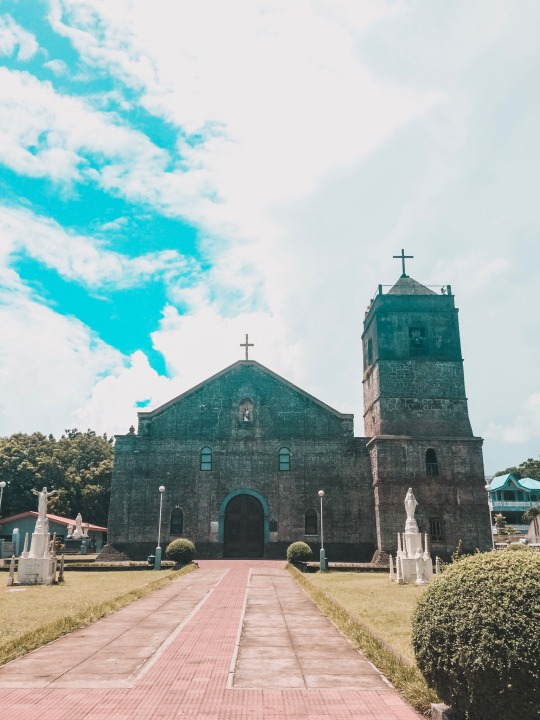

Schedule of Services
Sacraments
Masses
Monday to Friday: 6:00 am
Friday: 5:30 pm
Saturday: 6:00 am; 6:00 pm (Anticipated Mass)
Sunday: 5:30 am, 7:30 am, 4:00 pm, 6:00 pm
Baptism Edit
Saturday & Sunday: 10:30 am
Wedding
By appointment at the Parish Office
Devotions
Morning Prayer & Rosary: Monday to Saturday before the 6:00am Mass
First Saturday Procession: 4:30am before the 6:00am Mass
0 notes
Text
Tactically Naive: Serie A is back, baby!

Photo by Antonio Balasco/Pacific Press/LightRocket via Getty Images
Serie A is off to a roiling start (as long as you ignore Juventus). Also, a modest proposal to fix English football governance.
Hello, and welcome back to Tactically Naive, SB Nation’s weekly soccer column. We have edited out every mention of “BEN STOKES!” from what follows, but if you want the true immersive TN experience, just imagine somebody shouting it loudly in your ear every couple of sentences.
Serie A is back, baby!
You know it. Tactically Naive knows it. Everybody knows it, even if they like to pretend otherwise. No football season has really begun until Serie A is back, in all its beautiful scrappy sizzling silly glory.
Juventus won 1-0 to begin their march towards a ninth straight title. But the secret upside of this superclub age is this: you don’t have to care about the superclubs until they start losing. So, let’s not care about Juventus. Doesn’t that feel relaxing?
The beautiful things were happening elsewhere, anyway. In Florence, Fiorentina and Napoli shared seven goals and two hilarious VAR decisions: one a familiar story of pedantic handball, the other a joyful failure to notice that Dries Merten was throwing himself on the floor. Mertens also scored a banger, which was then outbanged by Kevin-Prince Boateng. Eventually Lorenzo Insigne scored the winner, and everybody had a well-deserved rest.
youtube
Elsewhere, more delirious nonsense. Three times Roma took the lead, the third by mere millimetres. And three times Genoa dragged them back to parity, the third thanks to a diving header of almost Platonic purity. Christian Kouamé, we salute you, and we salute your willingness to absolutely hurl yourself through the air for the sake of a point away at Roma.
youtube
Finally, a note for AC Milan. Of all the teams that could be/maybe should be/aren’t competing with Juventus, Milan are perhaps the saddest case. Manager after manager, false dawn after false dawn, all at the club that for many, including Tactically Naive, basically defined what Serie A should be. That heady mix of style, substance, and cynicism. Those wonderful thin stripes. That Paolo Maldini. Ah, to be young again ...
Milan had 60 percent possession against Udinese. Milan didn’t manage a single shot on target. And Milan lost.
The continuing adventures of VAR
More exciting developments in the Premier League’s ongoing implementation of Referees Watching Television (VAR). This week we discovered that VAR will apparently not overturn penalty decisions if they are wrong but not, like, totally wrong.
So if, for example, the referee had completely missed David Silva being tripped in the penalty area against Bournemouth, then VAR would have politely suggested that this was something to be considered. But because the referee saw it but didn’t think it was particularly important, then nothing doing. This puts VAR in the slightly peculiar position of intervening with bad decisions that aren’t made, but not bad ones that are made. Unless they’re, like, real bad.
In some respects this is no different to how things have always been: if a referee doesn’t agree with how things appear to be, then bad decisions follow. Yet somehow it’s more frustrating when there is a system in place that at least, in theory, has the capacity to reverse this, but for some reason isn’t allowed to. “The referee didn’t get that one wrong enough” doesn’t sound like a recipe for happiness.
Especially when, as with Silva, the referee seemed to get it completely and entirely wrong. Especially when offside is being legislated with such aggressive precision as to appear sarcastic. Especially when the presence of VAR is having a transformative effect on frustration, diffusing it out from one person to an entire system. Because individual humans make mistakes, but systems are faceless, monstrous, and almost certainly in thrall to a shadowy alliance of vested interests that all hate you and your football team.
Something terrible is very close to happening
In April 1888, 12 football clubs got together and created the world’s first professional football league. They called it the Football League, because they didn’t need to call it anything else. 131 years later, one of those founder clubs, Bolton Wanderers, is days from liquidation, after a takeover deal collapsed on Friday night.
As with all similar stories the details are particular but the broad strokes are the same. At some point the ownership of a football club passed to somebody who shouldn’t have been allowed to take charge of a football club, and then it all went wrong.
One of the great tragedies of professional football is that governing bodies — and this applies well beyond England — have generally failed to interpret their function as one of protective curation. Football clubs are businesses, of course, but they are so much more than that: they are grand tangles of social history and cultural identity; they are institutions that create, and were created by, communities; they are totems and monuments, parish churches and cathedrals; they are folk songs and love stories.
What Tactically Naive is saying, in essence, is that the Football Association should be dissolved immediately. To replace it, a broad coalition of heavily-armed librarians, working with extremely strong, strict readings of the words “Fit” and “Proper.” Neglect of football clubs is an act of violence against humanity as a collective. Vote TN for a happier Britain.
On a lighter note
Here’s the second most surprising thing to happen in Australian sport this week:
Meanwhile in an Australian #nonleague cup final....pic.twitter.com/tjFPfiJFbf
— Ollie Bayliss (@Ollie_Bayliss) August 26, 2019
0 notes
Photo
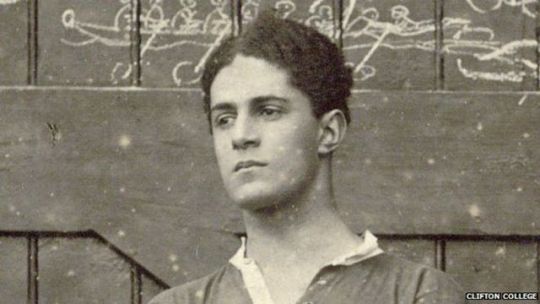
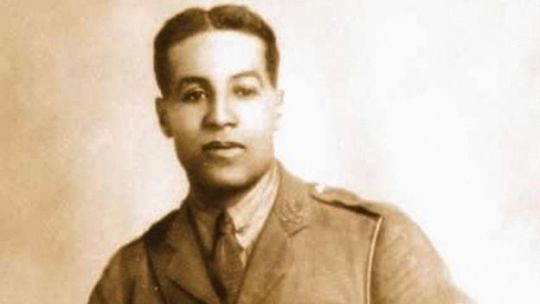
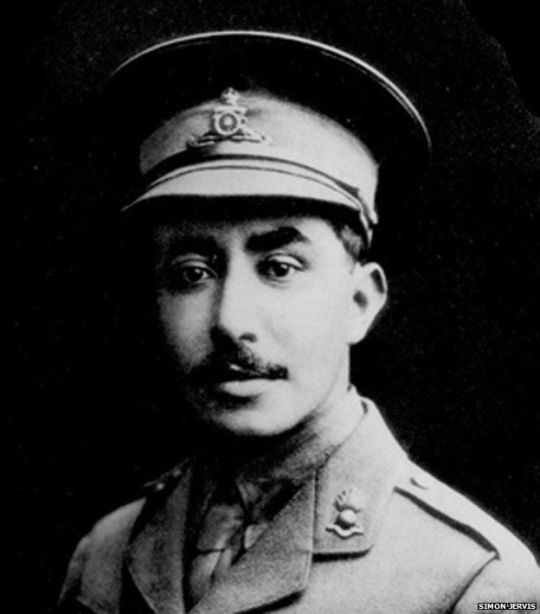
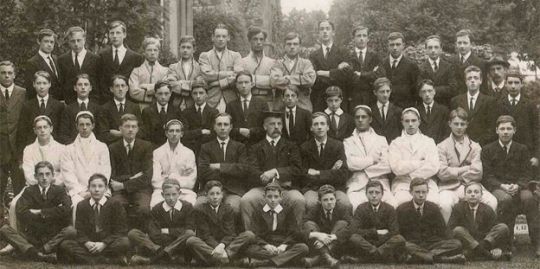
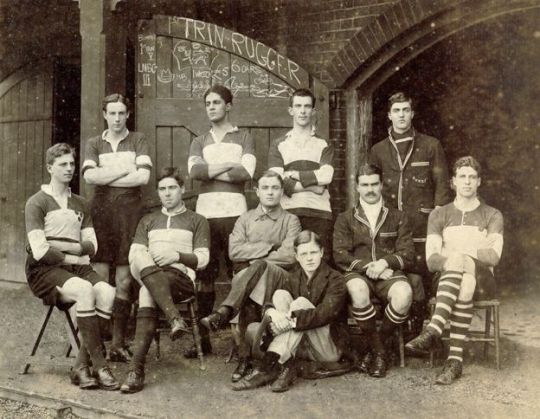
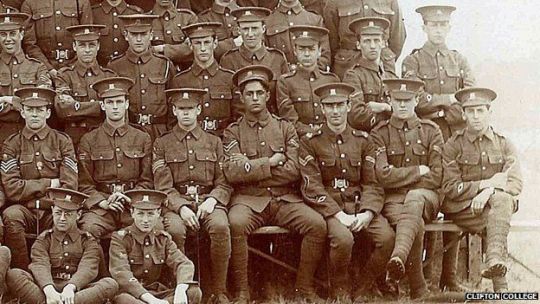
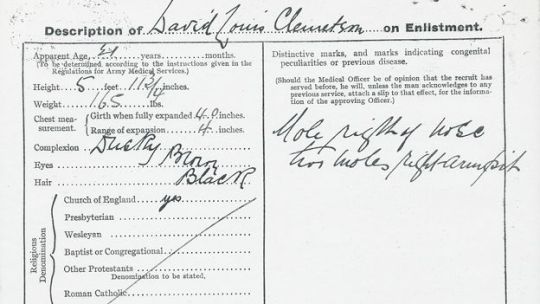
The officer who refused to lie about being black
When war was declared in 1914, a Jamaican, David Louis Clemetson, was among the first to volunteer.
A 20-year-old law student at Cambridge University when war broke out, Clemetson was eager to show that he and others from British colonies like Jamaica - where the conflict in Europe had been dismissed by some as a "white man's war" - were willing to fight and die for King and Country.
He did die. Just 52 days before the war ended, he was killed in action on the Western Front.
Clemetson's first taste of combat was in 1916 on the Macedonian Front, in Salonika.
"It is as much like hell as anything you can think of," wrote a soldier who served alongside the Jamaican.
On the frontline for eight months, under constant bombardment by big guns and badly traumatised by "shell-shock", or what's now known as post-traumatic stress disorder, Clemetson, a 2nd lieutenant, was evacuated to a military hospital in Malta.
Declared physically fit, but in need of psychiatric care, Clemetson was sent to Britain aboard the hospital ship Dover Castle, which, after a day at sea, was torpedoed by a German submarine and sank off North Africa on 26 May 1917. "Dastardly," a British newspaper roared. "The enemy must be punished!"
Rescued, the young Jamaican, who'd been diagnosed with "neurotic depression" and "stress of service" from his terrible time at the front, was taken in June 1917 to the Craiglockhart psychiatric hospital for officers in Scotland.
There, Clemetson was cared for, his medical records show, by Dr William Rivers. This pioneering physician developed a "talking cure" which helped heal soldiers who, frozen with fear from combat, were depressed, unable to sleep and eat properly, and were distraught at being branded cowards by many.
Also being treated at the hospital was the war poet Wilfred Owen, a 2nd lieutenant who had written about the futility of war and the waste of young life. Owen, like Clemetson, had been suffering from shell-shock. "These are men whose minds the Dead have ravished," reads Owen's poem Mental Cases.
Clemetson spent two months at Craiglockhart, and was almost certainly the only black officer treated there. While there, his name was mentioned briefly in the hospital magazine, The Hydra, edited by Wilfred Owen.
Two years before, in 1915, he became one of the first black British officers of WW1. But the 1914 Manual of Military Law effectively barred what it called "any negro or person of colour" from holding rank above sergeant, according to Richard Smith, author of Jamaican Volunteers in the First World War.
Nevertheless, Clemetson became a 2nd lieutenant in the Pembroke Yeomanry on 27 October 1915.
History has long recorded another black soldier, British-born Walter Tull, as the first to become an officer. But by the time Tull became a 2nd lieutenant in the Middlesex Regiment on 30 May 1917, Clemetson had been an officer for going on two years. There is a distinction - Clemetson was in the Yeomanry, part of what was then the Territorial Force, rather than the regular Army.
Another candidate for the first black officer is Jamaican-born George Bemand. But he had to lie about his black ancestry in order to become an officer. Bemand, whose story was unearthed by historian Simon Jervis, became a 2nd lieutenant in the Royal Field Artillery on 23 May 1915, four months before Clemetson became an officer and two years before Walter Tull.
When the teenage Bemand and his family migrated to Britain from Jamaica in 1907, and the ship he was on made a brief stopover in New York, Bemand, the child of a white English father and a black Jamaican mother, was categorised by US immigration officials as "African-Black". Yet, asked in a military interview seven years later, in 1914, whether he was "of pure European descent", Bemand said yes. His answer was accepted.
But Clemetson took a different approach.
"Are you of pure European descent?" he was asked, in an interrogation intended to unmask officer candidates whose ethnicity was not obvious and who were perhaps light-skinned enough to pass for white. "No," answered Clemetson, whose grandfather Robert had been a slave in Jamaica, he was not "of pure European descent".
By telling the truth about his ancestry, Clemetson threatened to disrupt the military's peculiar "Don't ask, don't tell" racial practices, which were conducted with a wink and a nod.
The recruiting officers would probably have preferred that Clemetson claim he was white and leave it at that. If others had followed Clemetson's stance, the military establishment could no longer claim, if pressed, that it barred men who were "negroes or people of colour" from becoming officers and that it kept leadership roles in the military for men "of pure European descent".
The question of race seemed to shape Clemetson's brief military career. Military officials spent a lot of time trying to categorise him.
In 1914, shortly after the war began, and Clemetson had enlisted, the Jamaican was examined by a military doctor. Asked to describe what "complexion" Clemetson was, the physician didn't write black or white in his medical report. Instead he decided that Clemetson was "dusky", or between light and dark.
The military did not know what to make of their new recruit, who they saw only in terms of the shade of his skin. But there was much more to the young Jamaican than this.
Clemetson had been born into a wealthy Jamaican family which had a complicated history. Clemetson's grandfather Robert, a one-time member of parliament in Jamaica, had been a slave. Robert's owner, who was also his father, freed him and went on to leave him money, a sugar plantation, and even slaves, in his will.
This dubious inheritance allowed the Clemetsons to emerge at emancipation rich and powerful, and part of a light-skinned black elite in Jamaica which dominated the British colony. Large landowners in St Mary's parish on the north coast of Jamaica, Clemetson's family also became rich in the banana trade after setting up, in partnership with an Italian-American family in Baltimore, a company to ship and distribute Jamaican bananas and other fruit in the US.
The money from these enterprises kept the Clemetsons in comfort in Jamaica and paid for their children to attend a variety of public schools and universities in Britain. David Clemetson attended Clifton College in Bristol and later Trinity College, Cambridge. One of the wealthiest young men in Jamaica, had Clemetson not gone off to fight, he would have returned home after university and settled down to life as a rural Jamaican landowner.
Instead, he responded to Britain's massive war recruitment drive.
Acknowledging the need for black and Asian men from its colonies, Britain enlisted the help of West Indians, Africans and Indians, who they confined mostly to segregated units and ordered to do some of the most dangerous and dirty jobs, among them digging and emptying toilets, burying the dead, and transporting live shells.
It's estimated a million Indians, 100,000 Africans, and 16,000 West Indians served in the rank and file, in segregated units like the British West India regiments. In Jamaica, Clemetson's cousin Cecil did all he could to encourage young men on the island to volunteer.
"All able-bodied men should go forward and show their patriotism," roared Cecil at a recruiting rally in St Mary's parish, Jamaica, in 1915. "No country's subjects were better treated," he claimed, "than those of the British Empire."
The British military hierarchy decided it could do no harm to turn a blind eye to its own racially discriminatory laws and allow a handful of black soldiers - among them Tull, Bemand, and Clemetson - to become officers, in charge of white troops.
But it was a fairly well-kept secret. Had they been aware, many Britons would have opposed even a small, select group being allowed to bypass the rules and give orders to whites. "The presence of the semi-civilized coloured troops in Europe was, from the German point of view, we knew, one of the chief Allied atrocities. We sympathized," Robert Graves wrote in Goodbye To All That.
But others thought this foolishness, faced as Britain was with possible defeat to Germany. Maj Gen Sir AE Turner said it would have been "the height of stupidity" not to allow "coloured subjects of the Empire… to take part in the war, and take their part… in crushing the Hun".
The black officers who did make it were remarkable men.
Walter Tull was a celebrated professional footballer. Another distinction might have been glowing recommendations from powerful military officials.
Education and class were a massive factor too. George Bemand came from a well-off family and attended a prestigious public school, Dulwich College. He had also been a member of the Officer Training Corps at University College, London, and been recommended by a Brigadier-General, AJ Abdy. The general scribbled earnestly on Bemand's application: "I am willing to take him."
Clemetson, of course, was wealthy and came from a planter family in Jamaica, attended a respected public school where he was a member of the Officer Training Corps, went on to Cambridge where he was in the rowing team, and also had recommendations from important military people.
He received a recommendation from Lt Col HJH Inglis of the Sportsman's Battalion of The Royal Fusiliers, the regiment Clemetson had belonged to in 1914 before he transferred in 1915 to the Pembroke Yeomanry to become an officer.
He had been attracted to the glamorous Sportsman's Battalion because it had advertised itself as a special unit for men who were at least 6ft tall and athletic, like Clemetson, who had played rugby and cricket at school before rowing at university.
Apart from the recommendation from Inglis, Clemetson also received encouragement in becoming an officer from FC Meyrick, a lieutenant-colonel in the Pembroke Yeomanry. Meyrick met and interviewed Clemetson. The Jamaican was, he reported, "in every way eligible and suitable for a Commission".
But besides the recommendations, the athletic prowess, and public school backgrounds, what it appears the military establishment most wanted black officer candidates to have, was light skin - preferably light enough to "pass" as white and fool all but the most observant.
Those who wanted to become officers but were darker-skinned, would often find themselves rejected, even if a powerful person, like the governor of Jamaica, intervened on their behalf. Take, for example, the case of Jamaican government official GO Rushdie-Gray, mentioned in Richard Smith's book.
Despite an agreement between Jamaica's governor and the War Office to make Rushdie-Gray an officer, when the Jamaican arrived in London in 1916 he was refused a commission because he was judged too dark-skinned.
"Mr Gray called today, he is presentable, but black," a War Office memo reads. "I am surprised at the Governor recommending a black man without previously informing us of his colour." There is, crucially, the memo says, "no absolute bar against coloured men for commissions… but that they did not expect Mr Gray to be the colour he is."
It appears, too, that George Bemand's younger brother Harold was blocked from becoming an officer for similar reasons. Both attended public school but while George, who was noticeably lighter than his younger brother, became a 2nd lieutenant, Harold became only a gunner - equivalent to a private. It was clear the military had decided if it was going to have black officers, they would be as light-skinned as possible.
On 26 December 1916, a year and a half after he became an officer, George Bemand, aged just 24, was killed by an enemy shell in France. On 25 March 1918, a year after he became an officer, Walter Tull, aged 29, was also killed in action on the Western Front in the "Spring Offensive". Tull's body was never recovered.
As for David Clemetson, after serving on the Macedonian Front in 1916 and being torpedoed and rescued on his way to Britain in 1917, he ended up at Craiglockhart. The hospital seems to have had a contradictory role.
Its job was to both treat the afflicted officers, but also to patch them up quickly and get them back to the front line.
Clemetson's medical records show in the two months he spent at Craiglockhart, doctors there couldn't seem to decide whether he was getting better, or was in need of more care.
On the one hand, a report reads, he was in need of "further treatment". But on the other hand, the report reads a few lines later, Clemetson had, it said, "improved much". Other reports show he was not sleeping much, and when he did he had terrible nightmares. His legs had also become so weak he could not stand properly and, the medical reports acknowledges, "his memory is not what it should be".
Clemetson did have some good news while at Craiglockhart. To his surprise, in July 1917, a letter arrived from the War Office informing Clemetson he had been promoted to full lieutenant, the only black person, it appears, to hold this rank in the British armed forces during the war.
Read more
Photographs:
David Louis Clemetson
Walter Tull died at the Battle of the Somme, March 1918
George Bemand lied about his black ancestry to ensure his commission
Clemetson pictured at Clifton College (front row seated, fourth from right)
Class was a factor as well as race: Clemetson (back row, 2nd from left) rowed for Trinity College, Cambridge
Clemetson in Clifton College's Officer Training Corps (front row seated, centre)
Clemetson's enlistment form - for the category "Complexion" a doctor has written "dusky"
#bbc#bbc news#david louis clemetson#don't ask don't tell#richard smith#jamaican volunteers in the first world war#jamaican#jamaicans#walter tull#george bemand#david clemetson#race#racism#white supremacy#war#wars#wwi#world war i#military#dusky#black soldiers#read more#long reads
0 notes
Text
PLOT
A Roman Catholic priest, Father Damon, murders a man outside a castle-like estate on an island in upstate New York. The man he kills claims to be Lucifer himself, and promises to return. Decades later, in 1963, Andrew Williams is born. After his mother is paralyzed under mysterious circumstances, Andrew’s father realizes something is peculiar about his son, eventually coming to the realization that Andrew is the son of Lucifer. As a senior in high school, Andrew is withdrawn and socially awkward, and as a result is often bullied by his peers. Andrew feels drawn to the estate where Father Damon committed the murder, which is due for demolition for an impending golf course.
At school one day, one of Andrew’s tormentors, Tony, attempts to harass him in the gym shower. Overcome by strange powers, Tony kisses him in front of their peers. The event leaves Tony hysterical, and he leaves, terrified of Andrew. Later, Andrew is notified that he has received scholarships to several Ivy League colleges, including Yale and Harvard, but is insouciant to the news. Meanwhile, a local elderly woman, Margaret, visits Father Daly at his parish, and discusses Damon, whom she knew personally; Father Daly insists Damon wrongly murdered the man, though Margaret believes he was in fact Lucifer, and Father Damon, a manifestation of the archangel Raphael.
During a gym class, one of Andrew’s classmates, Mark, inexplicably suffers ruptured organs during a dodgeball game and dies. Mark’s girlfriend, Julie, is distraught, and shortly after begins having bizarre visions of Andrew raping her. She later hears voices calling her Gabrielle (a feminization of archangel Gabriel), and is directed to Margaret’s home by the disembodied voice of Father Damon. Margaret appoints Julie her protégé to battle Andrew.
On the night of a school dance, Andrew arrives at the castle estate and invokes Leviathan and Beelzebub, and summons the undead from grave sites on the property. At a local bar, Andrew’s father drunkenly raves about his son being the devil before returning home and shooting his wife in the head. Simultaneously, a group from the school is showing an outdoor play retelling the life of Jesus. During the scene of the crucifixion, the actor onstage begins exhibiting real stigmata, causing the audience to flee in horror.
On the island, a group of teenagers arrive to party after the dance, including Tony, his girlfriend Marie, Brenda, and others. After arriving at the castle, they are accosted by the undead. Marie is killed, and Tony and Brenda flee to an upstairs room, where Tony finds he has inexplicably developed breasts. Andrew enters the room and kisses him, after which Tony stabs himself to death. Andrew carries Brenda outside and lays her on an altar, where he stabs her to death.
Margaret and Julie arrive on the scene, brandishing Father Damon’s processional cross, which causes Andrew to recoil. Margaret forces Andrew to recite the Lord’s Prayer, and he transforms into Mark, tricking Julie. Margaret intervenes, and he kills her by breaking her neck. Julie watches as Andrew transforms into Lucifer, but is able to defeat him with the power of Father Damon’s crucifix. The spirits of Julie, Father Damon, and Margaret—the three archangels—coalesce, as Andrew is engulfed and destroyed in a beam of a light.
This slideshow requires JavaScript.
BACKSTORY
Drawn loosely from the Book of Revelations, Fear No Evil deals with the incarnation on Earth of Lucifer, and his battle for supremacy over God’s faithful, a battle which ends with a confrontation with God Himself in a spectacular scene of Devine Intervention. La Loggia, who directed the film from his original screenplay and plans to score it as well, is fully aware of the similarities between his film and Hollywood’s big-budget Anti Christ extravaganzas, THE OMEN and OMEN II but he bristles at the suggestion that BEAST is a rip-off of previously-explored conventions.
Said La Loggia, ” Fear No Evil” is unique. We’ve gone ahead and actually personified the devil as a character and as a human being who is at odds with himself about who he is. Lucifer is a young man who is reborn in a little fishing village in upstate New York. He’s 18 years old and a brilliant student. He’s very much at odds with who he is, so he’s doing battle within himself at first, denying the evil that lurks within him, but then gradually giving way to it. He’s an extremely sympathetic character, one that I think the audience will want to hug and push away at the same time.
“While THE OMEN and THE EXORCIST were extremely slick and technically commanding,” he said, “they still missed the real point of the dilemma of what it must be like to actually be the devil.”
“The local newspapers were very intrigued by the whole idea,” he said, “and we gathered a lot of publicity. We had an open casting call at the local PBS station in Rochester and more than 2,000 people showed up in two days. I cast six lesser roles and the rest of them had an opportunity to work as extras. There’s a mass panic that takes place during the staging of a passion play in this little village. We had close to 2,000 people there for seven nights.”
It’s still a little early to tell if La Loggia’s claims for the film are based on hope or hype. There are lengthy editing chores ahead and the crucial search for a distributor. But La Loggia is confident the film will be in theaters this summer. “Two of the majors have already contacted us,” he said, “and unless I’m grossly mistaken, I’m sure the picture will win major distribution.”
To stretch the budget as far as possible, La Loggia tried to The accommodate many of the necessary special effects on camera. One of the most difficult effects scenes, in which the young Lucifer (Stefan Arngrin) uses his powers for the first time, took four days to get on film. The scene takes place during a high school game of battleball, in which opposing players try to hit each other with soft rubber balls. The coach, under Lucifer’s demonic influence, releases a ball at such terrifying speed that it kills one of the players. La Loggia and cinematographer Fred Goodich used a special rigging of wires (invisible because of the lighting and fast film speed) to make the sequence work.
John Eggett, our man in charge of live action special effects (as opposed to the optical, done in post production) rigged a harness in preparation for the death scene of Mark (actor Paul Habor), which takes place in the gym. The script called for Mark to be hit by a rubber ball that is under demonic control-hit so hard that he flies ten feet before dashing his brains out on a wall. It took ten grips to yank the harness rope with sufficient force for the effect; Haber was protected from real injury by a special rubber pad insulating the harness and a piece of sponge rubber attached to a wiglet that was crocheted into his real hair.
Special effects were also important. for the film’s finale. “We have a spectacular ending,” La Loggia said. “It involves Divine Intervention. A Godly light makes its way from the heavens and decides Lucifer’s fate. We secured as many of the elements as we could on camera through lighting. Those elements will be reinforced later in an optical house.”
Originally, Rob Blalack (who handled optical work on STAR WARS) was hired to handle post production effects. But Avco has shifted the responsibility to Peter Kuran’s new company, Visual Concept’s Productions. Kuran was in charge of rotoscope and cel animation on THE EMPIRE STRIKES BACK.
The film’s ending is suggestive of Ray Bradbury’s published version of how ROSEMARY’S BABY should have ended-with Rosemary scooping up her demon child, running to St. Patrick’s Cathedral, where she begs God to at last reclaim his cast out child. “Our picture ends with a plea from Lucifer for forgiveness.” La Loggia said. “But his plea doesn’t work. It’s a very compelling moment in the picture.”
The film’s opening and closing sequences were shot at Boldt Castle, a tourist attraction located on an island in the Thousand Island area of the St. Lawrence River. Built by a fella named Boldt” between 1900 and 1904 in homage to his ailing wife, it was abandoned after her death and allowed to fall into ruins. “We’re used to seeing a castle in a horror picture that’s opulently dressed,” said La Loggia. “But this place is abandoned, you could walk around in the daytime and get shivers.”
Richard Jay Silverthorn as Bonnomo, the earlier 1961 incarnation of Lucifer
BEHIND THE SCENES with Richard Jay Silverthorn Make Up Artist
“Here’s what I need,” La Loggia told me, his eyes sparkling with enthusiasm for his first feature production. “Can you do an army of walking dead? Design me a frightening face and body for Lucifer’s final revelation, something unique, something we’ve never seen before. Can you make a stomach wound that will pop open and squirt blood as if cut by an invisible knife? Or grow female breasts on a man?”
He showed me some paintings by Frank Frazetta that he felt conveyed the same “feel” he wanted for his presentation of Lucifer. His first draft at the time carried the title The Antichrist and concerned the Prince of Hell, incarnated as a high school student in a small town in New York state. The emphasis was to be on Lucifer as a fallen angel, who once had a place in heaven among the other archangels. To punch home his concept of the Antichrist, the lead character, Andrew, was originally conceived as a soulful young man with long hair and a beard-a Christ like countenance. This concept was changed later, when clean-shaven, boyish Stefan Arngrim made an electric impression at his audition and snared the lead role.
In turn, I showed La Loggia two of my USC graduate films which involved aging make ups, a mummy and rubber prosthetics. We shook hands, and I was told I had the job. While I waited for the end of the summer and the start of principal photograph, La Loggia firmed up the use of locations in Rochester, N.Y. interviewed others for various crew positions, and began auditions. Smaller parts were cast through “open call” auditions in Rochester, while the leads were chosen in Hollywood.
When Frank gave me a draft of the script to begin makeup budgeting, I was excited over the idea of playing the role of Bonnomo, the earlier 1961 incarnation of Lucifer, who has a spectacular death scene early in the film. I had always wanted to be a monster in a horror movie since I was a little kid, so I did a test makeup of myself as I saw the character When La Loggia saw the stills I had taken while he was in Rochester, he agreed that I should play the role. I was beside myself!
La Loggia showed me stills of the locations he had secured, including Lucifer’s unholy temple, the Boldt Castle: a real, crumbling, ruined and unoccupied castle on a little island near the town of Alexandria Bay, New York, the Thousand Islands. Alexandria Bay and Rochester were combined to make up our mythical fishing village of St. Lawrence, New York. For the next few weeks I fantasized being the Devil, and running through the shadowy clammy corridors of the Boldt Castle.
Boldt Castle
On July 19th I officially signed my contract with La Loggia Productions as actor and makeup artist, and began pre-production. Frank’s second draft changed Bonnomo’s scene, dropped other scenes and revised and tightened the whole. I had only $1,000 for makeup for the entire cast, so the effects and supplies had to be geared to necessity. Through early August my time was occupied with taking plaster casts of actors hands, chests and faces, assisted by Claire Ohlmiller, a professional hospital technician who does molds for artificial limbs. La Loggia Productions flew Stefan and me to San Francisco for fitting of the special yellow “cat’s eye” contact lenses made at a clinic there. At last, with all plaster molds wrapped in blankets and loaded on a truck bound for New York, moved out of the apartment I’d lived in for ? five years, and ended my lingering ties with the USC neighborhood.
We arrived in Rochester, New York on August 22, to be joined by our Rochester cast and crew, covered by TV cameras as celebrities. A real Hollywood horror film on location. Already the excitement was in the air. The crew was young, many between 19 and 25 years old, naive and eager to dig in. Since we all lived together in one motel (except for crew members who were Rochester natives) the atmosphere of camaraderie and mutual support happened easily. The La Loggia cousins, Frank and Charlie, held meetings with the heads of the departments regularly, to air questions, problems and insure that schedules were coordinated., Carl Zollo was head of the art department, Fred Goodich, Cinematography, (they were among our older crew members) and Dennis Carr, Sound Recording. There were various assistants in each department, as well as several assistant directors whose responsibilities were scheduling, transportation, crowd control, equipment handling and any other troubleshooting that might come up along the way. The assistant directors often stood between success and disaster in seeing that people and equipment were at the right place at the right time.
That first night in Rochester we had a crew banquet at which I met my assistants: Richie Bennett, who had done the impossible task of finding me a 5′ x 12′ walk-in oven to bake the huge plaster molds, Chip Leiberman, who followed me like a shadow on the set and had all my supplies ready for touch-ups like a nurse assisting in surgery, and Cheri Montesanto, daughter of Frank Montesanto, our hair stylist of Monty’s Unisex, a Rochester area salon. Hair styling and makeup were closely coordinated for the finished effect. Since there was an 18 year time span, this was skillfully indicated by Monty’s changing hairstyles and gray tones, (or dark rinses) as well as by my painted wrinkles.
Since a motion picture must be filmed according to the weather or availability of locations, or actor’s availability, rather than script order, we had to shoot all the high school scenes first, before the school year began. Spry High School in Webster, NY became St. Lawrence High. Because the semester hadn’t begun and the school’s boilers weren’t turned on, our actors had to take freezing cold showers for one of the first sequences put on film, where the class bully makes the mistake of picking on Lucifer in the gym shower. Professional troopers in spirit, the scene was shot without a complaint and stands out as a showcase of acting ability for Stefan Arngrim and Daniel Eden.
https://dailymotion.com/video/x2oqm38
A Rochester family with a lovely little house on the shore of Lake Ontario consented to the use of their house as a location. According to the script, the house degenerates as the marriage of Lucifer’s terrified parents, Mr. & Mrs. Williams, degenerates. The effect was accomplished by the art crew progressively messing up the house-shingles were torn, screens twisted, weeds and vines arranged all over the sidewalk and front porch for the most extreme result of 18 years of neglect. Then the entire house was cleaned and repainted, the front lawn edged and trimmed to neat perfection for the house’s original look before the birth of the little “bundle from Heaven.” Thus we left our hosts with their house in better condition than when our crew arrived. The shots were spliced into script order later, in the editing room. Since sequences here had to be shot according to ease of lugging cameras up and down stairs, as well as in reference to daylight, it was necessary to age Mrs. Williams (Alice Sachs), make her young again, and age her again for the final shot of the day. Once characters were made up, I was free to continue sculpting prosthetics which I started bringing to the set, in order to cut down night hours and still be available for touch-ups when actors got sweaty under the lights.
The opening title shot of the film runs over a very long camera dolly shot from Lake Ontario, around the House and to the front porch. Plywood was laid down in a track over which the dolly was pushed. Actors were cued into action as the camera approached and then passed them as they enacted guests at the baby Lucifer’s baptism party. Director La Loggia walked behind the moving camera, coaching the actors verbally since the scene was shot MOS (a term meaning “Mit Out Sound” which comes from the German immigrant directors who worked in Hollywood during the earliest days of sound filming.) Sound effects were added later.
Rain or shine, the filming schedule was adhered to whenever humanly possible. Certain night scenes were actually filmed during a light rain, which did not show up on film, but gave the actors an extra challenge-not to shiver. After filming at the house was completed, the crew moved equipment to Charlotte Beach, where the “Passion Play” scene was photographed. A panicking crowd scene was a plot element here, so ads were placed in the newspapers and radio for anyone wishing to appear in a horror film to show up at the public beach. A thousand eager people stayed on the beach for three nights starting from about 7 PM to 3 or 4 AM. Megaphone in hand, Frank La Loggia instructed the crowd in actions as they portrayed an audience coming to view an annual church play on the final days of Christ, only to be involved in an unbelievable horror-the actor on the stage actually bleeds and dies on the cross, and the audience experiences stigmatism.
Screaming and bleeding, the freaked-out audience runs in every direction for their lives. Some fall into the lake as lightning bolts (added in post production) strike all around. “All Hell breaks loose” with stage lights exploding from charges (called “squibs”) pre-set by John Eggett and his crew. These were later matched with hand-drawn lightning bolts. One of my best rubber prosthetics in the picture was the tissue-thin rubber stomach appliance so that “Christ’s” stomach could seem to be pierced by an invisible lance and run blood. A rubber piece of surgical tubing was run under the actor’s loincloth and glued to his stomach. A preslit rubber “skin” was applied over the surgical tubing with a “ripcord” of transparent fishing line attached. The other end of the surgical tubing was fastened by Eggert to a massive insecticide sprayer to pump blood through the stomach, to tubing run under the wig and behind the wrists. The effect was gruesome and realistic.
This slideshow requires JavaScript.
With all but one scene in the Rochester area shot, the cast and crew packed up for a day of driving to our next location, the Boldt Castle. All of the crew, that is, except for me and my high school assistants, who stayed behind to bake the foam rubber prosthetics in the large kilns at the Rochester Institute of Technology Ceramics Department. Richie Bennett was by then trained enough to take over makeup for Mrs. Buchanan’s head wound, and Chip and Cheri handled other characters’ basic make ups.
Working with plaster molds which in some cases weighed over 100 pounds and carried over a gallon of foamed rubber was a new experience for me. Fortunately one of my assistants was a little guy who could climb into the kiln, holding one end of the mold, and then position it and climb over it to get out. A special problem was temperature.
The foam rubber had to be cured for at least 3 hours at a temperature not more than 250 degrees or less than 200 degrees. However, the kilns were made to fire ceramics at temperatures over 1500 degrees, so that we couldn’t leave the kilns on, for very long. The gas had to be turned on and off and the kiln door opened and closed as the only means of keeping temperature constant. The first trial prosthetics came out either under-done or overdone until the method was perfected. Varying thickness of plaster in the mold was part of the problem, but we ended up with at least two acceptable prosthetics from each mold as a backup in case the rubber tore or a scene had to be re-shot. Every trace of plaster had to be cleaned before we left, since plaster is incompatible with ceramic and could have ruined any pottery or sculptures being created by the students.
Before leaving Rochester, I brought dental casting stone casts of teeth to a dental technician who instructed me in the making of our prosthetic “fangs.” A soft pink wax was sculpted over the mouth casts with metal instruments heated in a gas flame. Then a plaster matrix was laid over the wax until it hardened. The pink wax was boiled away, and dental acrylic resin used for making false teeth was applied into the space formerly occupied by the wax. This quickly set and was then drilled and finely-polished by a high speed drill with various precision attachments. Finally the teeth were painted with acrylic to match our gum color and define cracks and spaces between the fangs. They snapped over our own teeth and required no pastes or powders to hold them.
Rejoining the cast and crew who were now split between two motels in Alexandria Bay, I “youthened” Mr. and Mrs. Williams and Father Daly for the 1963 scene of baby Lucifer’s baptism. Here John Eggett had rigged up a baptismal font which would boil as a mysterious wind blew through the church, a Divine protest against the baptism of infant Lucifer.
Richard Jay Silverthorn’s novelization of the 1981 horror film Fear No Evil. The director sold him the rights for $1. Silverthorn’s novelization was published in 1981 as Satan’s Child
Starting Saturday, October 6, the most hectic on-the-set makeup work began: the Army of the Dead rising from their graves. Derek and Collin, my high school assistants took off the week from school to join us on makeup crew, as well as appearing in some background scenes as extras. For thirty ghouls, we needed every makeup hand we could muster. Corn flakes, Quaker oats and liquid rubber were applied to texture the skin for the “rotten” effect. Certain “key ghouls” wore prosthetics sculpted by Collin Pingleton one with an eyeball hanging out, another with the cheek ripped away and teeth exposed. These were combined with rubber bald caps and patchy applications of crepe hair and painted over with custom-blended rubber mask paint for the finished effect. Eggett rigged up a false wall for one ghoul to crash out of, buried another alive so that he could crawl up from a grave, and make two others break out of stone work. This army of the dead was supposed to be the construction workers who had built the castle and then been buried alive, only to be possessed by “stay-behind” spirits subservient with hot coco and coffee. It was strange to see rotten ghouls huddled up in blankets and parkas, looking out for the first snowflakes of the year and shivering together. They had to shed the protective clothing for tattered rags while before the cameras. Most of our ghouls were recruited by a production assistant from neighborhood bars, though some had auditioned in Rochester and were chosen for large, bulky bodies. One of our larger grips also doubled as a ghoul, and had to wade through near freezing water to drown two nude swimmers. Needless to say, this scene was strictly one-take. A special room in the castle was kept warm with a roaring fire as a refuge for the near-frozen.
Jack Holland, a fine old actor who portrays Father Damon, incarnation of the angel Rafael, arrived from Los Angeles for his two weeks of shooting. We hustled him off the plane and into a rowboat for the opening shot of the film, then put him into a burlap robe with a scruffy beard growth glued on and filmed his death scene in the insane asylum. The unfinished rooms in the basement of the castle doubled for the asylum. Some viewers may be quite disturbed by the many dead animals appearing in the first scene as the aftermath of a “black mass” my character of Bonnomo is supposed to have committed. May I assure the reader that the animals were purchased quite dead and frozen from a lab. It was difficult to eat our 3 AM dinner break after shooting that scene, but the convincing effect of the “suffering to all God’s creatures” that Lucifer vowed was powerfully conveyed by the arrangement of hanging bodies before the huge inverted cross. At last my scenes in the film were scheduled for shooting. On our house boat dressing room, Monty shaved my hair back into a severe widow’s peak; mortician’s wax was applied to make my ears pointed, and subtle shadings changed the lines of my face to Satanic, angular planes. With the yellow contact lenses in place, I had to be led to the set and rehearsed in my movements slowly, since I was nearly blind. Once the cameras were rolling, I thought only of the audience experiencing the presence of the Devil on the screen. I wanted to scare the hell out of them! Stretching my mouth wide open to show my fangs, I ran toward various markers which were light-colored so I could see them through the lenses. In one shot three grips had to catch me as I passed camera range and nearly knocked an expensive light over. The bright light was all that was discernible.
Since the final chase scene of the film is supposed to harken back to the beginning with the feeling of a predestined repetition, Stefan Arngrim was also in makeup and costume as the second incarnation of Lucifer. His chase scene with Julie and Mrs. Buchanan is shot for shot identical with Bonnomo’s chase by Father Damon before the opening titles. He ran through the corridor, chased by the ladies, and then I ran through chased by the priest, from the same camera angles.
Because of problems moving the generator and camera equipment around on the island, my second makeup had to be shot in sequence, although the hairline had previously been shaved back. Therefore I had to glue crepe hair in to match my own, as my character is revealed as Rossario Bonnamo, whom nobody in town suspected of being Lucifer except Father Damon and his sister Margaret (the incarnation of St. Michael). I command the golden staff of St. Michael to fly out of Damon’s hand, saying, “I will be re-born. Aiwasz!” (Aiwasz is a Satanic word calling on the powers of the Unholy Trinity). In this way, Lucifer defeats Rafael by outliving him through his next incarnation. Damon (Rafael) is accused of murdering Bonnamo and dies in the insane asylum, leaving Margaret (Michael) to hunt out Lucifer’s next incarnation (Andrew Williams) and join with the yet unborn angel Gabriel (Julie) to defeat him in the film’s final confrontation. John Egget rigged up a two-part duplicate cross which appeared to enter my heart and come out my back into the tree. We used Hershey’s syrup for my black blood. Fortunately for the cast and crew, the weather suddenly warmed up and shooting continued in a comfortable climate.
The shot of the three angels ascending into Heaven was shot during this warm snap. Here lights were hoisted high into the treetops, and in order to make the beam of light distinct to the camera lens, the smoke machine was used liberally. Cheri dusted a gold glitter into all the make ups as the actors are transformed by “The Rapture” promised in the Bible. Spectacular optical effects were added later to complete the images, shot on separate strips of film for each angel, to be composited as the three bodies become one in a whirling vortex of twinkles.
Then we were ready for the final revelation of “star student” Andrew, a pale and beautiful high school lad, into the inhuman and repulsive Lucifer, the Beast who was chased from Heaven by the Archangel Michael. The pre-made foam rubber face and ear prosthetics were only part of the full-body work that took 5 hours to apply, in Stefan’s motel room. Open sores, purple and yellow patches, and hair travelling from the inverted cross in the palm of the hand to the armpit, and from the ankles up the legs to join with the pubic hair revealed by the Black Mass robes were glued in place. All of the crepe hair had to be sprayed with Krylon acrylic to keep the wind from blowing it loose. False black fingernails were glued on, and then we were ferried over in a motor boat to the castle. It wasn’t hard for Kathleen Rowe McAllen as Julie to act repulsed by this being with three points on each ear, glowing eyes and fangs. Yet through all this makeup, the human part of Andrew still loves pretty Julie, and, hesitating to destroy her as he had destroyed Mrs. Buchanan, (portrayed by Elizabeth Hoffman) he gives her a few seconds in which to find the strength to take the golden staff and defy his power, shouting, “He is the Light!”
After a few pick-up shots left over from previous scenes, the crew packed up the equipment and left the castle in a pouring rain. We returned to Rochester for one last scene at the home of one of our investors, which was used as Julie’s house for the “seduction” scene and the scene where Julie’s boyfriend Mark (Paul Haber) proposes. Exhausted but fulfilled this crew of people from all parts of the country hugged their goodbyes and returned home to await the release of the picture. Frank La Loggia and the editors placed the newly developed film together in New York City.
After several months of negotiations, Frank and Charles La Loggia signed the distribution agreement with Avco Embassy Pictures. At this point only a “rough cut” of the picture existed, with gaps in sound effects and no music, titles or special effects. Working with executives from Avco, Frank finalized the order of the scenes and got the picture into its final number of seconds for music timing. Gifted with music as well as producing, writing and directing skills, La Loggia “scored his own film with a 33 piece orchestra under Avco’s post-production budget. The melodies are lovely and yet haunting, perfectly conveying the moods of the characters.
This slideshow requires JavaScript.
Fear No Evil’s soundtrack featured many punk and new wave bands from the late 1970s and early 1980s.
“Hey Joe” performed by Patti Smith
youtube
“Somebody’s Gonna Get Their Head Kicked In Tonight” performed by The Rezillos
youtube
“Blitzkrieg Bop” performed by the Ramones
youtube
“Psycho Killer” performed by Talking Heads
youtube
“Love Goes to a Building on Fire” performed by Talking Heads
youtube
“Delicious Gone Wrong” performed by Bim
youtube
“I Don’t Like Mondays” performed by The Boomtown Rats
youtube
“Lava” performed by The B-52’s
youtube
“Blank Generation” performed by Richard Hell
youtube
“Anarchy in the UK” performed by the Sex Pistols
youtube
Source Material
Cinefantastique v10 n03
Fangoria 11
Fear No Evil (1981) Retrospective PLOT A Roman Catholic priest, Father Damon, murders a man outside a castle-like estate on an island in upstate New York.
0 notes
Text
Fiddler’s Green Peculiar Parish

"Fiddler's Green Peculiar Parish Magazine"
Clint Marsh, editor
In the way that one does, drifting on the wave of interesting links on the internet, I stumbled onto this amazing esoteric magazine produced in the style of victorian pamphlets, called the Fiddler's Green Peculiar Parish Magazine.
Published by Wonderella and edited by Clint Marsh, who contributes throughout along with an amazing selection of authors and artists. Marsh's personal editorial approach to publishing make each issue a fascinating read on a wide range of topics.

Its style is like a softbound almanac periodical, laid out in three columns with a range of interesting subjects from all corners of the occult world. All of the issues have been bound in a thick green paper stock with a cloth-like surface texture in a remarkable spring green colour and impressed with metallic golden lettering across the top. The issues are handsomely decorated throughout with illustrations and stylistic advertisements from a selection of occult publishers and artists.
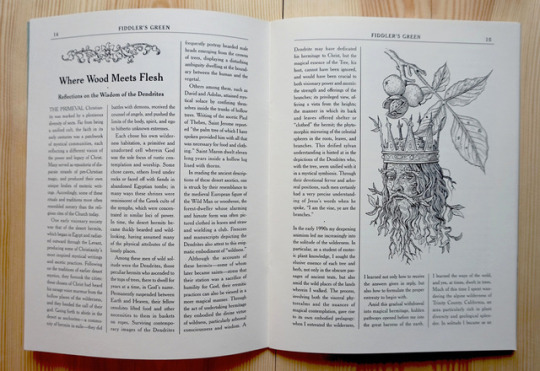
The history of small pamphlet publishing in magic and the occult goes back to the very start of the printing press. Two to eight page supplementals would be published as early as the 16th century detailing the accounts of trials of witches, gossip of goings on in royal circles and parish scandals related to bewitchment and cunning craft parsons.
In the late 18th century, a monthly periodical was even published called the "Conjuror's Magazine" that had a variety of material and subjects from tracts of Agrippa and translations of occult text to astrological and even slight of hand illusionist tricks. Under 40 pages each month for the distinguished occultist of the Georgian era.
What Fiddler's Green accomplishes is to bring back a sense of wonder and aesthetic beauty to magazine publishing. The attention to detail in the design is exquisite, with dozens of tiny subtle touches that make reference to obscure bits and pieces of publishing history. The paper a gentle butter coloured 'vellum' pleasant to the eye and to the touch.
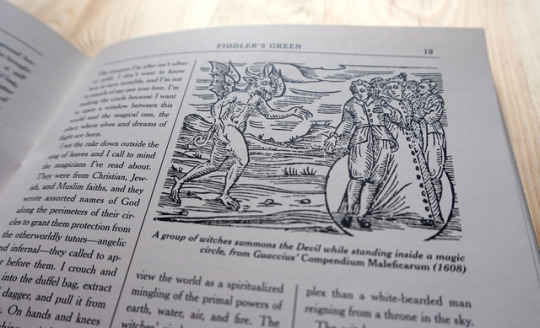
The magazine takes its name from the popular concept of the pre Christian afterlife of sailors, Fiddler's Green. A lush pastureland of endless summer nights filled teeming with wildlife. A place to gather and discuss the wonders from the world over.
The content is exceptional, a fascinating range of articles that covers reviews of books and periodicals, guest contributions from aforementioned occultists and artists, and presents it all in a package that speaks of a love for great design and a wide range of occult thought and creative endeavor. Marsh is to be commended in his efforts.
Since, as luck & charm would have it, I was sent all four copies of Fiddler's Green I will outline them with pics:
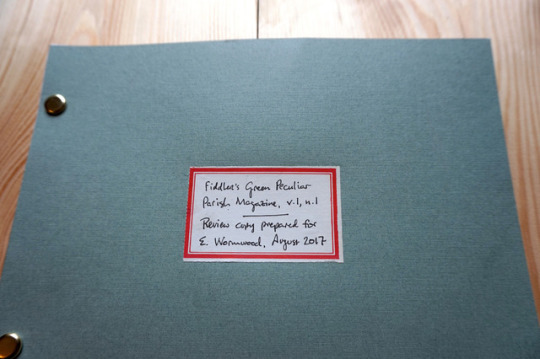
Issue one came to me as a handmade facsimile since it is absolutely sold out but the publisher wanted to give me a full overview. The first issue starts out strong, with interesting pieces, one comparing the mythological Basilisk to the emotional state of anxiety, occult perspectives on tea drinking as ritual, and all peppered throughout with insightful pieces by editor Clint Marsh.
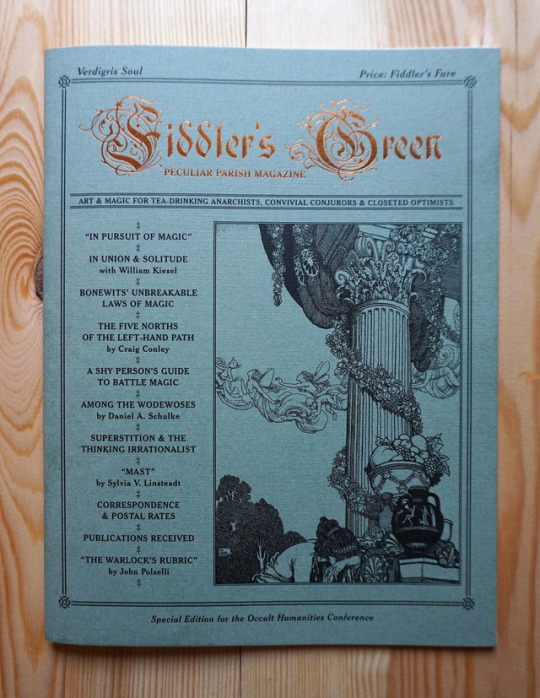
By the second issue, "Verdigris Soul" (a special edition for the Occult Humanities Conference), the content is even wider and more exploratory, with a lovely piece on Isacc Bonewits, an interview with William Kiesel of Ouroboros Press and a piece by Daniel Schulke, rounded out with Marsh's prose and all wrapped up in an incredible package consistent with the first in design but glowing in its presence.

Issue three, “Gardener’s Giantess," takes everything up a notch, the cover paperstock stays the same green cloth pattern cardstock, but with an added fold over flap on the front and back covers. It's a nice touch I have been considering adding to the next issue of Skeptical Occultist as it gives it such a clean and strong looking edge. Content wise the issue has a great mix of pieces from Clint, including one about his library, and finally a memoria of the late Michael Howard by Daniel Schulke.

The most recent issue, number four, "Crown & Crossroads", continues on with delightful content and beautiful design (though the cover flaps have gone) it delves into "the seductive nature of spiritual striving, the possibilities of voluntary wonder, self-sovereignty, etiquette, Goetic magic, the eeriness of the English countryside, the powerful messages and entities in Watership Down, and a poem on initiation and landscape." In particular Clint's piece on casting a magic circle is a wonderful personal narrative of practical magic and the entire issue is stuff full of beautiful illustrations and wonderful poetry and prose.
The central component that I really like about the Fiddler's Green Peculiar Parish Magazine is the idea of it being a catalyst for conversation and communication between the editor, writers and readers. The pay is listed in each issue as "Fiddler's Fare", which amounts to a likewise contribution in terms of practical issues, but is built on an idea of barter at its core, of community and dialog, which I find particularly interesting as an editorial statement. Each issue comes with an addressed envelop that affords its readers the chance to use old fashioned post to communicate with the publication, and ostensibly other readers through the letters column. In addition they have a reviews section titled "publications received" at the rear that is strongly reminiscent of my interest in youth 'zine culture in the 1990s.

"Fiddler's Green Peculiar Parish Magazine" is a wonderful publication bound to be thought of as a highlight in occult/esoteric journal & 'zine publishing of the early 21st century. A strong collection of voices with a range of ideas, historic references and incredible illustrations I look forward to many more issues to come.
Get your copy of issue four of Fiddler's Green from Wonderella here:
Fiddler's Green Peculiar Parish Magazine
#skeptical occultist#fiddler's green#folkwitch#witch#witchcraft#traditional witchcraft#hedgewitch#occult#occult books#grimoire#spellbook#daniel schulke#clint marsh#curse#hex#bruja#bruxa#witches#witchy#alchemy#necromancy#poisoner's path#Veneficium#maleficia#sabbatic path#wonderella#sidhe#fae#magic
302 notes
·
View notes